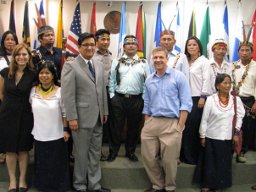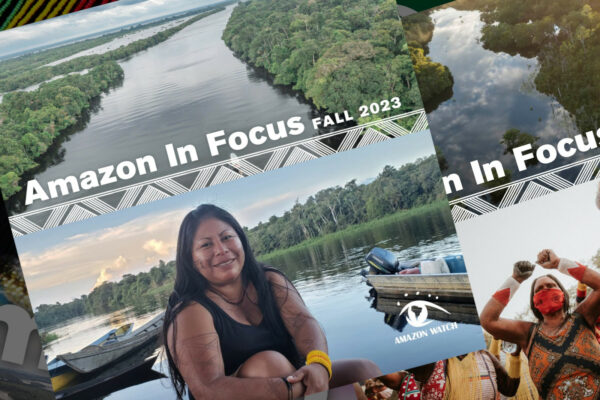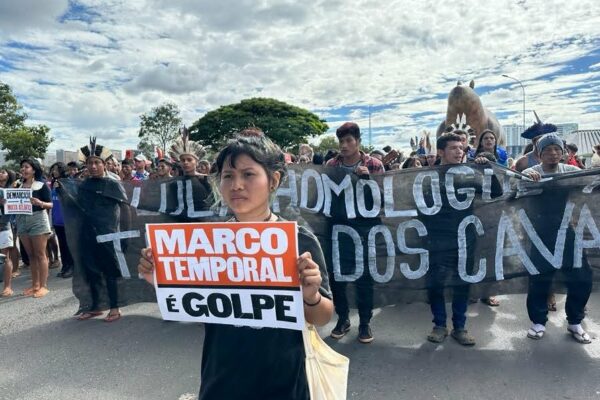
Over the past four years as an Amazon Watch campaigner, I have had the opportunity to meet some extraordinary indigenous leaders from around the region. None are more inspirational, however, than the tremendously savvy, well-organized, and persistent Kichwa from Sarayaku in the Ecuadorian Amazon.
Last decade, the Ecuadorian government made the mistake of trying to force oil exploration on the Kichwa, without any prior consultation. When the community pushed back, the government sent in military forces and the companies used nefarious divide-and-conquer strategies, including inciting violence. This is of course standard across the Amazon. In this case, however, the colluding forces of government and oil companies didn’t comprehend how fierce and dogged the community’s resistance would be.
Sarayaku is the model par excellence of how to wage a multi-pronged strategy on behalf of the rights of an indigenous people. The foundation is perpetual local-level community organizing, including an effort to build leadership and involve all sectors of the community. Building upon this, they have reached out to allies on national and international levels, strengthening a widespread network of support in Ecuador, Latin America, the U.S., and Europe. A third element is a commitment to building their own in-house technological and media outreach capacities.
All of this was evident this past week when a significant component of their international strategy – bringing the Ecuadorian state to court before the Inter-American human rights system – culminated before the Inter-American Court of Human Rights in Costa Rica. Because Amazon Watch’s Ecuador Program Coordinator Kevin Koenig was otherwise busy back in Quito, I was tasked with accompanying them in San José. Previously, I had met a number of their leaders and organized meetings and media interviews for a delegation when they were in Washington, DC in late 2009.
By strategic choice, they turned the Court’s hearing room into Little Ecuador, replicating their own dynamic and strengths to the degree possible. First, they brought an impressive group of community leaders, elders, and children, totaling 18. Then, they invited many indigenous and civil society allies to accompany them. Of course their lawyers from Fundación Pachamama and CEJIL were there. Additionally, their entourage included Humberto Cholango, the new president of Ecuador’s national indigenous alliance CONAIE, a campaigner from Amnesty International’s London headquarters, various other long-time allies, and myself from Amazon Watch.
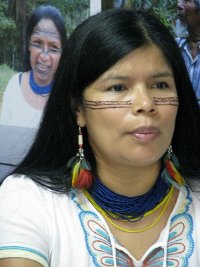
Sarayaku harnessed the power of media and internet technology to get the word out about the landmark hearing, and to keep their own community members informed about each of their activities. Prior to their trip, Sarayaku whiz kid Eriberto Gualinga produced a short video as a popular introduction to the delegation’s plans. They held multiple press conferences, in both Quito and San José, which garnered an increasing amount of coverage as the hearings drew near. The hearings themselves were telecast via the Court’s website, and watched simultaneously on multiple continents, including within Sarayaku.
On Wednesday, the first day of the hearing, they prepared by dressing in traditional clothing and painting their faces with ceremonial designs. The group marched from their hotel to the Court and performed a ceremonial act immediately outside, bringing the full spiritual force of their homeland to the Los Yoses barrio of San José. The ceremony involved drumming, dancing, the invocation of a sacred song by 90-year old spiritual elder Sabino Gualinga, and the nasal inhaling of tobacco juice. Some 40 people, both friends and functionaries of the Court, watched on.
In the Court’s hearing room, Sarayaku offered four witnesses, each of whom provided powerful and often emotional testimony. Patricia Gualinga spoke out and served as an interpreter for Sabino Gualinga and Ena Santi, both of whom delivered their testimonies in Kichwa. Marlon Santi, former president of both Sarayaku and CONAIE, broke down crying after entreating the government to respect the community’s rights and to leave them to live in peace.
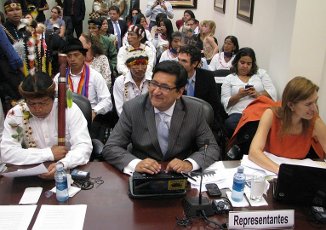
Though not a witness, Sarayaku President José Gualinga made a statement on behalf of the community in the final oral arguments session on Thursday afternoon. He concluded stating that “We have always, and will always protect and nurture our Mother Earth, the forest that nourishes us every day. We from the world of the Kichwa culture are always ready to defend the right to life and the rights of nature.”
Expert testimonies were provided on Thursday morning. James Anaya, the UN Special Rapporteur for the Rights of Indigenous Peoples, spoke at length about the state of indigenous rights. He noted that, “Unfortunately, today there persists a line of thinking that continues with the image of the indigenous as a savage, though perhaps not using this word, and uses this image to justify new acts of undermining indigenous participation. But fortunately, there exists another line, one of recognition, appreciation, and inclusion of indigenous peoples. This line of thinking is a threat to the legacy of the history of oppression. This new line manifests itself in new international instruments, like the UN Declaration on the Rights of Indigenous Peoples, and new constitutions like that of Ecuador.”
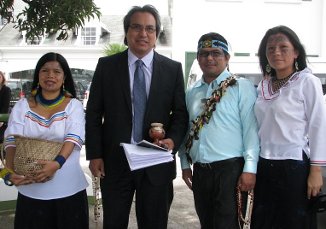
The Ecuadorian State’s arguments were emblematic of how governments attempt to defend their egregious behavior. Some were standard – That oil development is essential to the broader development of the country and that the local communities are an obstacle to such. Others were bizarre – that the court having issued protection measures for Sarayaku somehow lessened the security of neighboring communities. Implicit within the latter argument is the notion that the Ecuadorian state has pushed that Sarayaku is the perpetrator of violence against their neighbors. This point was made by one of the State’s witnesses, David Gualinga, a Kichwa individual who was expelled from Sarayaku 15 years ago and has since had a contractual relationship with oil companies and the government. Bringing a competing indigenous voice to the court is a standard tactic, attempting to demonstrate that there are conflicts amongst the indigenous groups.
James Anaya addressed this final point when he noted that many indigenous conflicts are brought on by outside interests.
The broader implications of the Sarayaku case
The Sarayaku case, focusing on events in 2002 and 2003, is really about the future of the indigenous territories which cover the great majority of the Amazon rainforest. The Correa government is currently in the process of repeating the same violations of indigenous rights via expansion of oil exploration throughout the southern Ecuadorian Amazon without the consent of numerous affected indigenous peoples. A favorable judgment in this case would add pressure for the Ecuadorian government to finally enter into good-faith consultation with affected and vulnerable communities.
The Sarayaku case is emblematic of dozens of other situations across the Amazon rainforest in which governments have promoted extractive industries, including oil extraction, mining, and mega-dam construction, against the express wishes of local indigenous peoples. A strong judgment in favor of Sarayaku’s claims would provide additional moral and judicial weight to the Amazon-wide demand for drastically improved protection of the rights of indigenous peoples and the defense of their environment.
The Court’s judgment is likely to be made before the end of 2011. As in the case against Chevron, the eyes of the world are closely watching the legal outcome of the Sarayaku case within the Inter-American human rights system. Whatever the decision, however, the people of Sarayaku will continue to campaign for respect of their rights, and Amazon Watch will continue to support them.


